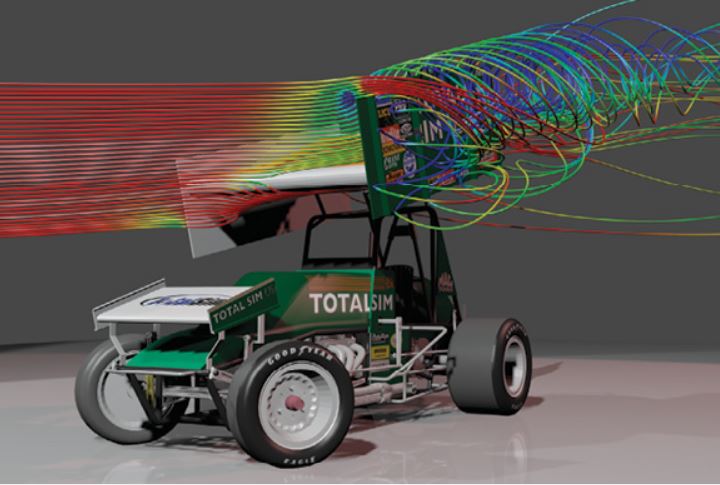Simulation-as-a-Service On-Ramp
Simulation is transitioning from a highly specialized operation performed by experts at the end of the design process to a more ubiquitous activity that can help optimize products throughout the design cycle. That means companies are doing more simulation and asking for results much faster.
Cloud-based solutions that enable simulation-as-a-service—either through complete outsourcing of simulation or opportunistically accessing simulation tools on an as-needed basis—have made this easier.
“Whereas a few years ago clients were really not averse to bringing simulation tools in house, development schedules and markets are moving at such a fast pace that clients are willing to pay a premium to leverage outside expertise and resources,” says Scott Herndon, manager of simulation client development for CFD (computational fluid dynamics) and FEA (finite element analysis) at IMAGINiT Technologies. IMAGINiT offers cloud-based Autodesk products, and has also developed its own mini-cloud resources on its own supercomputers.
“The costs of simulation were too big of a barrier for smaller companies,” says Ray Leto, president of TotalSim. “The idea of simulation-as-a-service is to take all of the expertise and resources [and] put it in a black box with an easy-to-use interface so that customers can walk through it and use it as they need it.”
“With smaller companies that have not used HPC in the past, by having access to the cloud they are able to run bigger jobs once they outgrow what they can do on a workstation,” says Gabriel Broner, vice president and general manager of HPC at Rescale.


Although the availability of cloud-based simulation-as-a-service solutions is expanding, in some cases these operations require the transfer of large amounts of data or the use of simulation tools that require very low latency. This can prove to be challenging, particularly for small- to mid-size businesses (SMBs) that may not have access to direct, high-speed connections to cloud providers or other network infrastructure.
“The reliability of the network is critical because the last thing you want is to put a lot of work into putting a solver into the cloud and have it fail because of a bandwidth or data connection issue,” Herndon says. “We rarely have issues with that, though, and it happens much less now than it did in years past.”
The availability of new high-speed networks can enable new types of services. Simulation services company TotalSim, for example, has been able to leverage access to a local gigabit fiber network at its home base in Dublin, OH, as well as the resources of the statewide OARnet (Ohio Academic Resources Network) 100G regional network and the Ohio Supercomputer Center.
“I can’t overstate how important it is for us within the city of Dublin to have access to these networking infrastructures,” says Leto.
Leto’s company was involved in a project to make simulation applications available to customers using those high-speed network resources. Working with researchers at Ohio State University and other technology partners, TotalSim was able to offer simulation capabilities to customers with very little latency. “We’re not networking people, so we’re not always thinking about the challenges on that side of the problem,” Leto says.
The push for municipalities to expand their gigabit network infrastructure, and then offer access to those networks ilike they offer access to water, sewer and other utilities, will help make these cloud-based applications easier to use and access.
That is because the network plays an important role in making these applications work for users that need real-time responsiveness, says Prasad Calyam, assistant professor of computer science at the University of Missouri College of Engineering, who worked with TotalSim on the project while he was acting as research director at the Ohio Supercomputer Center/OARnet at Ohio State University. “Integrating the various desktops and HPC systems, storage and other collaborators, and providing connectivity across them can provide a huge improvement in workflows,” Calyam says. “It helps improve the gains in time, cost, effort and convenience. Networking really drives this transformation to the cloud.”
Companies are also finding other ways to tap into cloud-based simulation resources. Workload data can be placed directly in the cloud so that the data is not moving back and forth between the user and the cloud infrastructure.
At Rescale, customers can connect via the public internet, while Rescale manages connections to cloud services providers. “We also have the ability to offer dedicated high-speed links,” Broner says. “For customers that already have some systems on premise, we can work collaboratively with them to determine what jobs are good candidates to move to the cloud.”
High-Speed Access in Ohio
In Dublin, TotalSim teamed with the city, Ohio State University, the OARnet network and other entities to create an app-based approach to providing access to simulation and compute resources to local businesses.
The team at OSU worked with TotalSim, which uses HPC resources to test virtual prototypes for clients in the aerospace, automotive and manufacturing markets. The problem TotalSim wanted to solve was to find a way to provide access to data-intensive services without overwhelming the public network and bogging down simulation activities for its clients.
The project was funded in part through an award from US Ignite, a nonprofit focused on helping to create services and applications that leverage advanced networking technology. Launched in 2012 by the National Science Foundation and White House Office of Science and Technology Policy, the initiative has helped launch and support Smart Gigabit Communities (funded by the NSF) that offer access to high-bandwidth networks (among other things). Those cities include Cleveland, Austin, Chattanooga, Kansas City and others.
The project was named “Best Application for Advanced Manufacturing” at the US Ignite Next Generation Application Summit in Chicago. Researchers from the Ohio Supercomputer Center (OSC), OARnet, Ohio State University, the City of Dublin, Metro Data Center (MDC) and the University of Missouri-Columbia (MU), in partnership with TotalSim, VMware and HP, were awarded $25,000 to develop “Simulation-as-a-Service for Advanced Manufacturing.”
The application allows users to remotely access the software and compute resources through a virtual desktop-as-a-service system for manufacturing. Users access results of simulations via a thin-client connection to a virtual desktop, whereas the heavy lifting of the large data sets is handled on the DubLink and OARnet fiber networks.
Dublin rolled out its own gigabit network called DubLink, which serves as the backbone of the project. It connects to Metro Data Center, a regional supercomputing facility in the city and runs parallel to OARnet, Ohio’s statewide 100 gigabit network.
Calyam says the project built on existing networking resources that had not, to that point, been operationalized with any applications. Funds from winning a Mozilla competition helped launch the prototyping phase, and Calyam was able to obtain a donation of cloud data center GENI racks and last-mile fiber connections.
“They created a modeling and simulation service that people can access as if they had their own solution because of the speed and low latency of the fiber network,” says Glenn Ricart, founder and CTO of US Ignite. “They can rotate models in real time.”
By reducing latency, the application allows better real-time collaboration between TotalSim and its customers, which can speed up iterations.
Having local infrastructure was critical, as distance between the companies using the app and the compute resources can affect latency. “Even if you have a gigabit network all the way from here to Oregon, you can’t necessarily provide the responsiveness you’d get having the application hosted in Dublin and distributed over local Dublin fiber,” Ricart says.
Network Alternatives
Although high-speed fiber networks are expanding, and the number of Smart Gigabit Communities is growing, not every small or mid-sized company has an on-ramp to this infrastructure. Fortunately, there are other ways to successfully access cloud-based or hosted simulation solutions.
At Rescale, customers submit simulation jobs and are able to match them to the most effective compute architectures for that particular project. “Having more bandwidth is always going [to] help things for SMBs, but even without a gigabit connection, there are a lot of workloads that can run in the cloud really well,” says Ryan Kaneshiro, chief architect at Rescale. “The sweet spot is probably CFD jobs that have small input file sizes and generate a lot of output data. You can do post-processing remotely through a remote visualization node or batch load processing script to whittle down the amount of data that needs transferred back to the local workstation.”
For other jobs with larger data transfer needs, more bandwidth is crucial. “That said, it isn’t the only option,” Kaneshiro says. “If you are talking about static data sets, a lot of that information is already sitting in the cloud. If it’s a one-time transfer, then there’s also the option of shipping hard drives to Amazon or Microsoft or whatever provider you are using.”
More direct connections are also available. “We see direct connections filtering down to SMBs as cloud usage starts to grow,” Kaneshiro says. For example, services like Megaport can help companies establish those direct connections to cloud services.
US Ignite’s Ricart says that high-speed networks will always have some latency limitations because of the speed of light and the way the fiber networks are designed (which is typically not in a straight line and requires several hops). “Every time you take a signal and put it through a router, that creates a delay,” Ricart says. “Both the speed of light and the number of times you have to make a connection run the clock when it comes to latency.”


TotalSim has successfully worked with clients across the country by using its app design to work around the latency issue. “What we’ve found is that the way we’ve designed the UI (user interface) side of the web application, and the latest software stack, is that it has allowed rendering and visualization and transfer of data to be faster than it used to be,” Leto says. “A person in California that is accessing the apps is still looking at a web page coming out of the Ohio Supercomputer Center. We’re just sending images and charts and graphs to be rendered in a browser, which is very lightweight and fast.”
Where the company does see a challenge is with interactive 3D post-processing or manipulation. “But every year the tools are getting better, and people are figuring out how to make the rendering work faster and the remote visualization capabilities through the browser are getting better,” Leto adds.
Taking advantage of solutions that offer different access options is important for making simulation-as-a-service work for smaller companies. Leto says that “bare metal” HPC installations provide the best bang for the buck when it comes to CFD simulations. Public cloud services like Amazon or Google can provide greater scalability.
It’s also important that the various high-speed networks typically available in larger cities can be coordinated and integrated as these high-speed networks expand, and that’s been a big part of US Ignite’s efforts. “We are rapidly seeing the ‘gigafication’ of the American internet,” Ricart says.
With a local hub that connects those networks, communities can reduce latency; otherwise, traffic may flow hundreds of miles away before it can be relayed and exchanged between network providers. Cities can establish digital “town squares” where a variety of applications and services are available for use. That presents an opportunity for companies with heavy simulation needs to access compute resources they would otherwise be unable to afford, while helping cities attract and retain high-tech businesses.
“In the case of Dublin, the city is already invested in data centers and has resources they can use as incentives for companies,” Calyam says. “If TotalSim is using this, then other companies will look at it and be able to do a cloud-based transformation. Those companies are much less likely to relocate to another city because they have these resources.”

